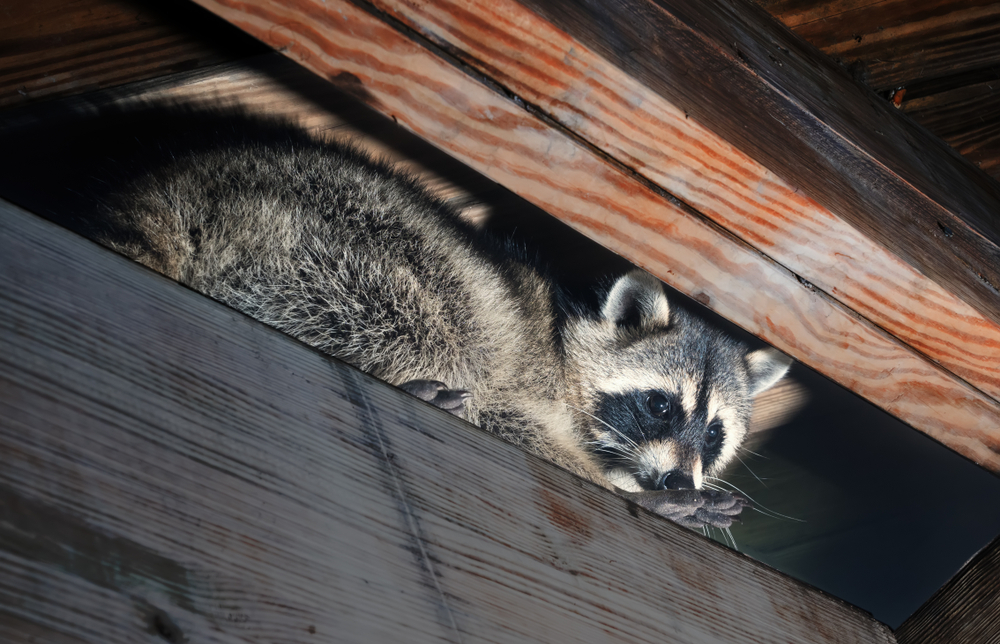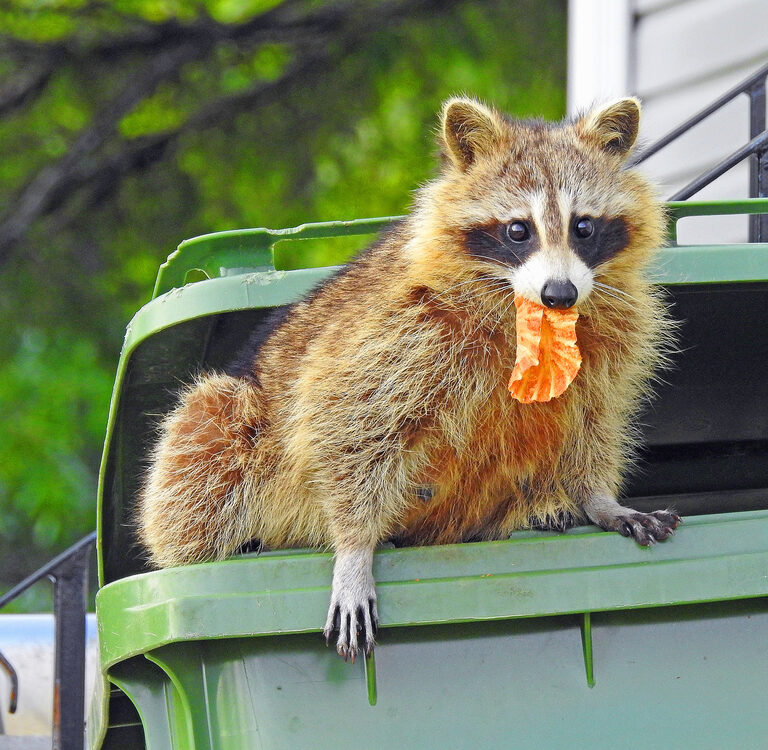Raccoons get into everything. They have the nickname of “trash pandas” for a reason, as they’ll likely get into your garbage cans once they’re on your property. And while raccoons can be cute, they also do a lot of damage around the home. For a homeowner, learning how to get rid of raccoons is essential to preventing an infestation.
However, the annoyance doesn’t stop there—a female raccoon might create a nesting site in your attic or crawl space or under your deck, making the removal even more difficult. A raccoon can also carry fleas, ticks, lice, and rabies, and their droppings could contain Baylisacaris procyonis, a roundworm egg that is extremely dangerous to human children.
Taking a proactive approach is a good idea because once they’ve set up a home in your house or yard, getting rid of the raccoons becomes more challenging.
Determining the Severity of Your Raccoon Problem
Before trying to get rid of the raccoons near your home, it’s crucial to determine the size of the issue. Ask yourself the following questions:
- Do you know for a fact that you have raccoons on your property, or could it be something else?
- Is it a family or a single animal?
- Are they returning frequently?
- Do they have a nest?
Answering these questions goes a long way toward developing a raccoon removal strategy. To help out, pay attention to the following clues on your property to determine the size of your problem.
Raccoon Feeding
Start by looking for evidence of raccoon feeding. Having your garbage cans knocked over is the obvious sign, but you might also notice bite marks in your garden vegetables, empty pet food dishes, or a disturbed compost pile.
Raccoon Tracks
Next, search your property for tracks. These tracks should show you where the raccoons are traveling in your yard and give you insight on whether they’re nesting or just passing through in search of a meal.
Raccoon Droppings
Searching for droppings is also a good idea. These droppings are typically about two to three inches long, tubular in shape, dark in color, and sometimes contain undigested berries. Identifying raccoon droppings is vital because these animals tend to defecate before entering a structure or climbing a tree. If you see droppings, it could mean that these pests are nesting somewhere on your property.
Getting Rid of Raccoons From Your House
Once raccoons get into your house, calling an exterminator might be your best option. However, there are a few things you can try beforehand that will save you a few bucks.
Light
For starters, raccoons like to live in the dark. They’re primarily nocturnal animals and choose to nest in attics, crawlspaces, and chimneys because there isn’t much light there. Therefore, it stands to reason that you can make your home less hospitable by adding light to these places. Even a small flashlight can be enough to force a raccoon family to move to a darker location.
Noise
Raccoons also like it quiet. They’re generally pretty skittish animals that you can scare off with noise. Sitting around making noise all day and night isn’t possible, but you can place a radio in the areas you’ve seen raccoons in the past to keep them away. The radio doesn’t have to be loud; the unfamiliar noise coming from it is often enough of a deterrent.
It’s also likely that you’ll hear raccoons before you ever see any evidence of them. Hopefully, these noises come from outside your home because that gives you time to take some preventative measures to ensure they don’t make their way into your attic or chimney.
Ammonia
Perhaps the best method of removing raccoons from your home is using ammonia. Raccoons can’t stand its smell, so stuffing a few ammonia-soaked rags in strategic locations around your home could force them away from your property. Known entry points are the best spots to place these rags.
Avoid Poison
Don’t use poison unless you have a plan for removing the animal afterward. Not only is poisoning the raccoon inhumane but, assuming it works, you’ll have a raccoon body in your home, and you’ll have to remove it somehow.
Remember, raccoons are looking for quiet, comfortable places, and following these tips lets them know that your home no longer provides this for them.
Avoiding a Raccoon Infestation – Removing Food Sources
The best way to keep raccoons away from your property is to make your home and yard unattractive to them. When doing so, you should:
Secure Your Trash
The main reason why raccoons will visit your property in the first place is for the food. Your garbage cans are like a buffet, so making sure these pests can’t get in is essential. We suggest getting a heavy one with a locking lid.
Tying the cans to a post or putting them in a rack makes it far more challenging for the raccoons to knock them over and enjoy their spoils.
Pick up Your Fruit
If you have fruit or nut trees in your yard, don’t let the rotting fruit sit there because it will provide a free meal for neighborhood raccoons. By taking a few minutes daily to remove any fruit that has fallen into your yard, you can make the property less hospitable.
Protect Your Garden and Compost
Your garden and compost are other food sources that could attract raccoons and other pests to your yard. However, protecting your garden is easier said than done because it’s not like you can pick your vegetables every day.
Use an Electric Fence
One solution is putting an electric fence around your garden. While installing chicken wire or other fencing is a bit easier, raccoons can dig under it or find different ways through, over time. An electric fence will scare them off, and they’ll learn to stay away from your garden and compost site.
Put Pet Food Inside
It’s perfectly fine to feed your pets outside, but don’t leave the food on your porch overnight. Better yet, bring the food inside anytime your dog or cat isn’t eating it because your community raccoons will treat this food like it’s their own.
Never Feed Them
Not feeding raccoons in your yard might seem like common sense, but it happens more often than you might think. These animals are cute, and if you have some extra scraps sitting there after dinner, it can be tempting to give these pests a free meal.
However, doing so will cause them to return, and you might even end up with a mother raccoon building a nest on your property because of the food you’ve provided.
By following these tips, you can ensure that local raccoons don’t see your yard as a place to grab a bite to eat and, hopefully, move onto another property that has easier access to food.
Removing Potential Nesting Sites

While getting rid of potential food sources is vital to keeping raccoons away from your yard, it’s only half the battle. That’s because mother raccoons are always looking for nesting sites, particularly in the spring when they typically give birth.
Raccoons tend to nest near food sources, but removing food from your yard doesn’t always make your property uninhabitable. A neighbor could have a fruit tree or unsecured trash cans, and your porch might make the perfect nearby shelter.
Clear Debris
The first thing you’ll want to do is ensure that your yard is free from unnecessary debris. A raccoon can build a nest in a woodpile and under shrubbery. Try to remove these options from your property to make it more difficult for them to settle.
Trim Branches
It’s also advisable to trim any tree branches that provide access to your roof because raccoons can get into your attic or chimney once they get up there.
Restrict Roof Access and Seal Entry Points
In some cases, it might not be possible to restrict access to your roof. If you find yourself in this situation, it’s a good idea to seal off your chimney with a cap or a spark arrester. Once a family of raccoons gets into your chimney, removable is exceptionally challenging, so being proactive in this situation is your best bet.
Of course, chimneys aren’t the only places raccoons build nests, so sealing other entry points is also recommended. Using galvanized mesh to seal off the areas beneath your deck, porch, or tool shed is a good start. Raccoons can dig, so you’ll want to bury the mesh about six inches deep in the soil to ensure they can’t get under it.
You don’t want raccoons nesting on your property, so following these tips and making your home and yard unattractive to them is always a good idea.
Final Thoughts
Raccoons are a nuisance, but having them on your property doesn’t mean you have to sell your home and start from scratch. The key is removing food sources and potential shelters from your house and yard to encourage these pests to move elsewhere.
Remember, taking the necessary preventative measures can prevent a raccoon infestation. Still, even if you have these animals in your home or yard, you can take some steps toward eliminating them quickly and safely.
